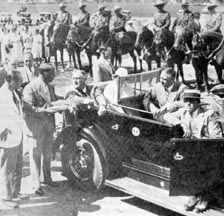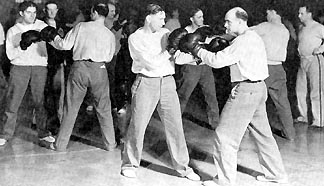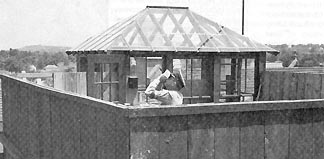WallkillThe Roaring 'Twenties ended with a bang in 1929. The zany Jazz Age, with its flappers and bootleg booze, showed its underside -- Scarface Al Capone and a "crime wave." The stock market crashed. Suddenly impoverished speculators leaped to their deaths from skyscraper windows, while a series of prison riots, including three in New York state, swept the nation. From the market crash came the Great Depression. From the rubble of the riots came a new type of prison, unguarded by a wall or even a fence. Throughout the '20s, New York's prison count had been steadily rising, from about 6,600 in 1920 to about 9,700 in 1926. In that year, to combat the seeming lawlessness of the era, the Legislature enacted the Baumes Laws. These laws stiffened penalties for repeat offenders, with a mandatory life sentence for a fourth felony conviction. The Baumes Laws also restructured the "good time" law, so that good time earned by a prisoner was deducted from his maximum rather than the minimum sentence, effectively lengthening sentences. The changes not only bred resentment, but exacerbated overcrowding in the state prisons at Auburn, Sing Sing and Clinton. Great Meadow was upgraded to maximum security in 1928, and a fifth prison - Attica - was in the planning stages. On July 22, 1929, as the prisons reached critical density, an escape attempt turned Clinton into bedlam. Three convicts were shot dead trying to scale the wall; vandalism and fires caused . . . property loss. Six days later, at Auburn, four prisoners escaped and another two were shot in the attempt. Two officers were killed . . . Six buildings were destroyed. A second Auburn riot occurred in December. . . .eight prisoners were killed . . . Three convicts were executed . . . . Investigators recommend medium-security prison While the ashes were cooling, an appalled Legislature appointed a Commission to Investigate Prison Administration and Construction, chaired by Sam Lewisohn. In its 1930 report, the Lewisohn Commission recommended, in general, a program stressing rehabilitation and, in particular, construction of a reduced-security institution to case overcrowding. The state acted quickly. Construction of Wallkill, a wall-less facility for men, was underway in less than 18 months. A prison without a wall or fence would not be entirely experimental. As the Commission noted, the federal government and several other states were operating institutions of this type, and New York had its own precedent in Great Meadow, which opened without a wall in 1911. Great Meadow was intended for first offenders, but the state was unable to find suitable candidates to fill its cells. Meantime, other prisons were doubling up. Great Meadow began receiving recidivists, and a wall was built around it in 1928. For its second try at a prison without walls, New York purchased a large tract of land in Ulster County two miles north of the village of Wallkill and 60 miles north of New York City. The 950-acre site consisted of rolling green hills, surrounded by farms and apple orchards, with the jagged, picturesque Shawangunk Mountain Ridge to the west. Architect Alfred Hopkins, who would later draw similar plans for another new prison at Woodbourne, submitted a design of interconnected Gothic buildings of gray stone, with steeply sloped roofs, massive oak doors and an enclosed courtyard in the center overlooked by cathedral windows. The impression is of an old, conservative English college -quiet, dignified, a place for serious study for Wallkill from the start was intended as a prison where inmates would be sent for education.
Contracts for construction were let in July, 1931. A first contingent of 29 inmates arrived on March 1, 1932, by transfer from Clinton. They were employed at construction and on the farm and were housed in wooden buildings - one a converted barn - called camps, with double bunks. Additional prisoners were later sent from Elmira and Sing Sing. The new prison was ready for partial occupancy on November 1, 1932, and was completed in 1933. Wallkill’s design features four three-story housing wings. Each of the 12 stories or galleries contains 42 outside cells, 21 on either side of a corridor, for a total of 504 cells. The most radical feature of Wallkill's housing - still probably the first thing noticed by a visitor - is that the cells have no plumbing. Each gallery has a bathroom, and the doors of the cells, more properly called rooms, are not locked, unless by the inmate who has the key. Each floor also has a recreation room. Rooms in the basements are used for classrooms and other inmate activities. Parallel to the housing wings and extending all the way along the back of the facility is a long, flat-roofed building containing the mess hall, laundry, gymnasium, vocational shops and a new suite of schoolrooms. In the 1940s, chapels were built in the attics of two of the housing wings. St. Peter's Protestant Chapel was dedicated in 1944 and the Catholic Chapel in 1948. Each was funded by private donations and constructed with inmate labor. The Protestant Chapel was destroyed by fire in 1986, but was soon reconstructed in the same English Gothic style matching the prison exterior. Dr. Wallack's education program In addition to recommending a wall-less prison, the Lewisohn Commission recommended that New York extend the reformatory philosophy to its adult inmate population. New York "should develop a prison system which will protect society from the criminal and his evil deeds by endeavoring to reeducate and retrain these men and women." "Mass treatment," the Commission said, should be replaced by "a system of ... individual treatment and training." The Commission intended that Wallkill would be "manned by high-grade personnel to afford specialized training adapted to the need of individual prisoners." It should also receive the best prospects: men, said Commissioner of Correction Dr. Walter N. Thayer, Jr., "whom we feel will be receptive to the program we are endeavoring to set up there - a training and rehabilitative program." In 1935, legislation was enacted creating the position of Director of Education for the Correction Department. The first appointee to this position was Walter M. Wallack, Ed. D., a product of Columbia University Teachers College who had served as educational advisor to the Lewisohn Commission. The new, statewide emphasis on education would be most filly realized at Wallkill. Aided by a grant from the Carnegie Corporation and assisted by the Curriculum Laboratory of Columbia Teachers College, a two-track academic course was developed. It was geared specifically for adult prisoners, leading to either a Regents diploma or high school general equivalency. The vocational curriculum offered training in 24 trades, with formal tie-ins to the academic side as well as planned coordination with the facility maintenance department for on-the job training. To provide the focus on individual needs suggested by the Lewisohn Commission, Wallkill organized New York's first service unit," the forerunner of today's guidance units. The service unit staff acted as both classification unit and program committee, assigning each inmate to a plan of activities to remedy his deficiencies. Regarding the whole of prison life as preparation for post-institutional life in the community, Wallkill's service unit was a cooperative undertaking with Division of Parole staff. The Wallkill approach would become state policy in 1971, when the independent correction and parole agencies were merged in a new Department of Correctional Services.
Wallack was soon able to broaden his educational efforts to include staff when legislation in 1936 established the eight-hour day for prison guards (as officers were then called), requiring the rapid appointment of 536 new men, Commissioner Edward P. Mulrooney seized the opportunity to professionalize the staff by creating a training school. He designated Wallack to chair a committee to develop operating plans and a curriculum for new recruits as well as in-service training for existing personnel. Wallkill was selected as the site for the nation's first school for security personnel. The Central Guard School, with eight-week sessions, opened in November, 1936, but was closed in 1939 by budget curtailments. It reopened in 1940, but closed for good in 1942 when great numbers of the uniformed force were called up for military service in World War II. In 1940, after succeeding on the civil service examination, Wallack was appointed warden of Wallkill, succeeding Leo J. Palmer, who had headed the facility since its opening Shortly after his appointment, Wallack acquired the authority to recruit his own inmates: Wallkill staff periodical by traveled to the prisons to review records and interview prospective transferees. An exception later allowed staff at the Elmira Reception Center to make selections from among new admissions; otherwise, Wallkill continued to select its inmates into the early 1970s. In the 1960s, Warden Wallack was casting about for ways to bring the vocational training program up-to-date when an in-law suggested there were job opportunities in the growing field of optical manufacture. When Bernard Kaplan, a self-employed frames and lenses dispenser, paid a routine sales call in 1965, he found in the warden an unexpectedly aggressive interrogator. Discovering that the salesman had taught at an optical school, Wallack overwhelmed and "practically kidnaped" Kaplan, finding him a room to sleep in and setting up a classroom the next day. The nation's first prison optical program was underway. Kaplan started with 10 inmate students, teaching them optical theory and the ancient craft of grinding optical glass by hand. Before long, students were able to grind lenses that met national standards, and began to fill prescriptions for WalIkill inmates. Eventually, a correctional industries production component was added to the instructional shop, making lenses for other Department facilities and for agencies of the City of New York. In 1974, the first piece of modem equipment (a generator) was acquired. Beginning in 1992, Corcraft started to work with the state Department of Social Services to provide eyeglasses to some of the state's Medicaid recipients. Today, Wallkill’s Optical Shop employs 110 inmates on two shifts, manufacturing 135,000 pairs of glasses a year. Dr. Wallack, who served as president of the American Correctional Association in 1954, managed Wallkill for 26 years until his retirement in 1966. Changes come... not always smoothly In 1945, WalIkill started a prison Alcoholics Anonymous program, the first in New York and thought to be the third such program in the United States. . . . Since 1989, the facility has also offered an Alcohol and Substance Abuse Treatment (ASAT) program, staffed by an ASAT counselor. The 330-hour ASAT program serves 40 inmates at any one time. In 1976, Wallkill was selected as the first DOCS facility to offer the Family Reunion Program (overnight, private visits for inmates with spouses and other family members). The program had a rough beginning. Five mobile trailer homes were delivered to the site, but had not yet secured to the ground, when a storm arose - lifting the trailers off the ground and scattering them in pieces about Wallkill’s fields. They were quickly re¬ placed, however, and the program has functioned well ever since, serving as a motivator for good inmate conduct as well as strengthening the family ties believed to be important to successful adjustment after release from prison. . . . In 1984, . . . Wallkill set up a sanctuary for retired racehorses The private Thoroughbred Retirement Foundation, which relies on charitable donations from the public, purchased 50 acres of land adjacent to the facility. The Foundation pays feed and veterinary expenses; DOCS provides an experienced horse handler and a dozen inmates to care for the animals, which would otherwise be destroyed. In addition to offering vocational training with post-release employment possibilities, the daily care of 40 magnificent, powerful, but totally dependent horses tends to change inmates' attitudes toward other living things and themselves as well. As Teddy Roosevelt once said, "There's something about the outside of a horse that's good for the insides of a man." Retired thoroughbreds are not the only animals on Wallkill’s grounds. The facility currently farms about 450 acres, with 70 dairy cows and a 150-animal beef herd, substantially reducing food costs. . . . .
Wallkill’s appearance has changed very little in 66 years. A new visitors' building, erected in the 1970s, abuts the front northwest wing; a small medical building, inconspicuously nestled between two wings on the opposite side, opened in 1996. These harmonize in design and color with the older structures. In 1985, about 30 acres of field and trees were appropriated for a new maximum-security prison, Shawangunk, situated about a half-mile away from Wallkill. Only once has there been a threat to spoil the vision of the Lewisohn Commission. In the 1950s, after three inmates banged a hole through the cement in one of the housing wings and escaped, a fence was erected around Wallkill’s perimeter. In 1971, new Superintendent Harold Butler persuaded Albany officials that the fence was an unnecessary eyesore and received permission to tear it down, restoring the look and feel of New York's most distinctive adult prison. |
Return to menu listing NYCHS excerpts of DOCS|TODAY Facility Profiles.
Return to NYCHS home page..
 |
 NYCHS is honored to be permitted to present these excerpts from the Facility Profile: Albion article appearing in the March 1999 issue of DOCS|TODAY. All rights to the text and images remain with DOCS. To access 2003 on-line issues in Adobe Acrobat format (PDF), including the unabridged Facility Profile articles, visit the DOCS|TODAY menu page on the DOCS web site by clicking on the logo above. NYCHS is honored to be permitted to present these excerpts from the Facility Profile: Albion article appearing in the March 1999 issue of DOCS|TODAY. All rights to the text and images remain with DOCS. To access 2003 on-line issues in Adobe Acrobat format (PDF), including the unabridged Facility Profile articles, visit the DOCS|TODAY menu page on the DOCS web site by clicking on the logo above. |



